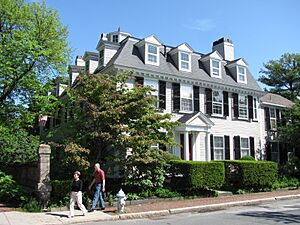Tory Row facts for kids
Tory Row is a special part of Brattle Street in Cambridge, Massachusetts. It's known for its beautiful old mansions from the 1700s. During the American Revolutionary War, many wealthy families who supported the British King lived here. These families were called Loyalists. Some people use "Tory Row" to describe this specific area, while others use it to refer to seven important colonial houses along the street.
These historic homes, like the William Brattle House and the Longfellow House–Washington's Headquarters National Historic Site, show us what life was like long ago. A writer named Samuel Atkins Eliot said in 1913 that Tory Row was "not only one of the most beautiful but also one of the most historic streets in America." The families who built these grand houses, like the Vassalls and Royalls, gained a lot of their wealth from large farms in places like Jamaica and Antigua. Many people were forced to work on these farms without pay, and a significant number of people also worked in the mansions themselves under similar conditions.
Exploring the Seven Historic Houses of Tory Row
Seven famous houses make up what is known as Tory Row. Each one has its own unique story and history. These homes give us a glimpse into the past of Cambridge.
- The Brattle estate (42 Brattle Street) is also called the William Brattle House. Today, it is home to the Cambridge Center for Adult Education, a place where people can learn new things.
- The Estate of Mrs. Henry Vassall (94 Brattle Street) is known as the Henry Vassall House. It stands as another example of the grand homes from that era.
- The Estate of Mr. John Vassal (105 Brattle Street) is a very famous house. It's known as the "Vassall-Craigie-Longfellow House." Now, it is the Longfellow House–Washington's Headquarters National Historic Site, a place you can visit to learn about history.
- The Lechmere-Sewall house (149 Brattle Street) has a few names, including the "Lechmere-Riedesel House."
- Judge Joseph Lee's house (159 Brattle Street) is now called the Hooper-Lee-Nichols House. It is home to History Cambridge, which used to be the Cambridge Historical Society.
- The Fayerweather House (175 Brattle Street) was built by George Ruggles. It is also known as the Ruggles-Fayerweather House.
- The Thomas Oliver house (33 Elmwood Avenue) is sometimes called the Oliver-Gerry-Lowell House or Elmwood. Even though its address is on Elmwood Avenue, it's still considered part of Tory Row because that street used to be part of Brattle Street.
What Happened to Tory Row Houses After the Revolution?
After the American Revolutionary War ended, many things changed for the Loyalist families who lived on Tory Row. The new government in America took over some of their properties.
Five of these large estates were taken by the government and then sold. For example, the estates of Lechmere and Oliver were sold to Andrew Cabot in 1779. The Sewall estate was sold to Thomas Lee in 1779. The Vassall estate was sold to Nathaniel Tracy in 1781.
However, not all houses were taken. The families of Borland and the Widow Vassall were able to keep their homes. General Brattle had given his property to his son, Major Thomas Brattle, before the war. Major Brattle was able to get his estate back after the war, thanks to the hard work of his daughter, Mrs. Katherine Wendell. She helped prove his loyalty to the new country.
Two other Tory Row houses were not taken by the government. Judge Lee, who lived at 159 Brattle Street, returned to his home after the war and lived there peacefully until he passed away. Captain Ruggles, who owned 175 Brattle Street, had sold his estate to Thomas Fayerweather in 1774, before he left the area.
See also
- Old Cambridge Historic District, which includes Tory Row


